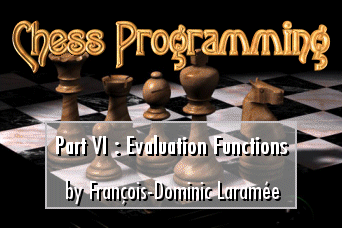11/10 - 11/12 @ Montréal, Canada
12/5 - 12/7 @ Shanghai, China
12/24 - 12/27
2/28 - 3/4 @ San Francisco, CA
More events...
2406 articles in the reference section.
Help us fight cancer!
Join SETI Team GDNet!

|
Material BalanceTo put it simply, material balance is an account of which pieces are on the board for each side. According to chess literature, a queen may be worth 900 points, a rook 500, a bishop 325, a knight 300 and a pawn 100; the king has infinite value. Computing material balance is therefore a simple matter: a side's material value is equal to MB = Sum( Np * Vp ) where Np is the number of pieces of a certain type on the board and Vp is that piece's value. If you have more material on the board than your opponent, you are in good shape. Sounds simple, doesn't it? Yet, it is by far the overwhelming factor in any chess board evaluation function. CHESS 4.5's creators estimate that an enormous advantage in position, mobility and safety is worth less than 1.5 pawns. In fact, it is quite possible to play decent chess without considering anything else! Sure, there are positions where you should sacrifice a piece (sometimes even your queen) in exchange for an advantage in momentum. These, however, are best discovered through search: if a queen sacrifice leads to mate in 3 moves, your search function will find the mate (provided it looks deep enough) without requiring special code. Think of the nightmares if you were forced to write special-case code in your evaluator to determine when a sacrifice is worth the trouble! Few programs use a material evaluation function as primitive as the one I indicated earlier. Since the computation is so easy, it is tempting to add a few more features into it, and most people do it all the time. For example, it is a well-known fact that once you are ahead on material, exchanging pieces of equal value is advantageous. Exchanging a single pawn is often a good idea, because it opens up the board for your rooks, but you would still like to keep most of your pawns on the board until the endgame to provide defense and an opportunity for queening. Finally, you don't want your program to panic if it plays a gambit (i.e., sacrifices a pawn) from its opening book, and therefore you may want to build a "contempt factor" into the material balance evaluation; this allows your program to think it's ahead even though it is behind by 150 points of material or more, for example. Note that, while material balance is highly valuable in chess and in checkers, it is deceiving in Othello. Sure, you must control more squares than the opponent at the end of the game to win, but it is often better to limit his options by having as few pieces on the board as possible during the middlegame. And in other games, like Go-Moku and all other Connect-N variations, material balance is irrelevant because no pieces are ever captured.
|
|
|
|
|